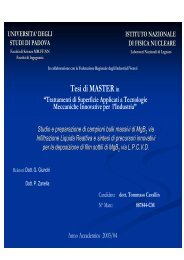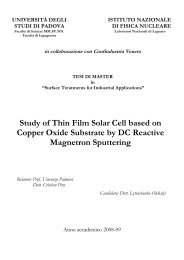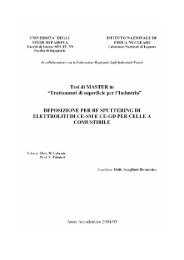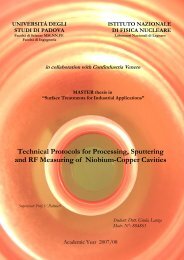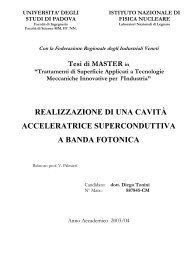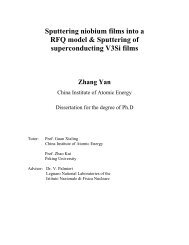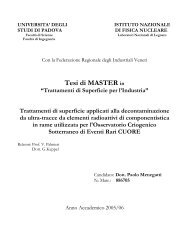Magnetron sputtering of Superconducting Multilayer Nb3Sn Thin Film
Magnetron sputtering of Superconducting Multilayer Nb3Sn Thin Film
Magnetron sputtering of Superconducting Multilayer Nb3Sn Thin Film
Create successful ePaper yourself
Turn your PDF publications into a flip-book with our unique Google optimized e-Paper software.
Fig. 1.4 The A15 crystal structureThe first inter-metallic compound with the typical A 3 B composition was thechromium silicide Cr 3 Si was discovered in 1933. [11] Several other compounds <strong>of</strong> theA15 structure were found in the following years. No large interest existed in theresearch on those compounds, but this changed with the discovery that Vanadiumsilicide V 3 Si showed superconductivity at around 17 K in 1953. [12] In the followingyears several other A 3 B superconductors were found. [13] Niobium-germanium held therecord for the highest temperature <strong>of</strong> 23.2 K from 1971 till the discovery <strong>of</strong> thecuprates in 1986. Although some A15 phase materials can withstand higher magneticfield intensity and have higher critical temperatures than the NbZr and NbTi alloysNbTi is still used for most <strong>of</strong> the applications due to the easier manufacturing. [14]Nb 3 Sn is used for some high field applications, for example high end MRI scannersand NMR spectrometers.According to the Table 1.2 and Table 1.3, some candidates <strong>of</strong> high T c materialused for accelerator are: NbN, V 3 Ga, V 3 Al, Nb 3 Al, Nb 3 Ge, V 3 Si and Nb 3 Sn. Thecompare <strong>of</strong> these materials [8] is shown as follow:NbN:Because <strong>of</strong> its high critical temperature <strong>of</strong> 17.2 K, NbN is the only B1 simplecompound that has widely tested for accelerating cavities. Mainly two differenttechniques have been investigated: Thermal diffusion <strong>of</strong> N into Nb followed byrapid quench cooling and Reactive Sputtering onto Nb cavities. Rather seldomNbN applied to superconducting cavities gives better results than those obtainableby bulk Nb or Nb sputtered Cu. The main reason for this is the anomalously highresistivity <strong>of</strong> NbN in the normal state, which, even if not always reported in the10



